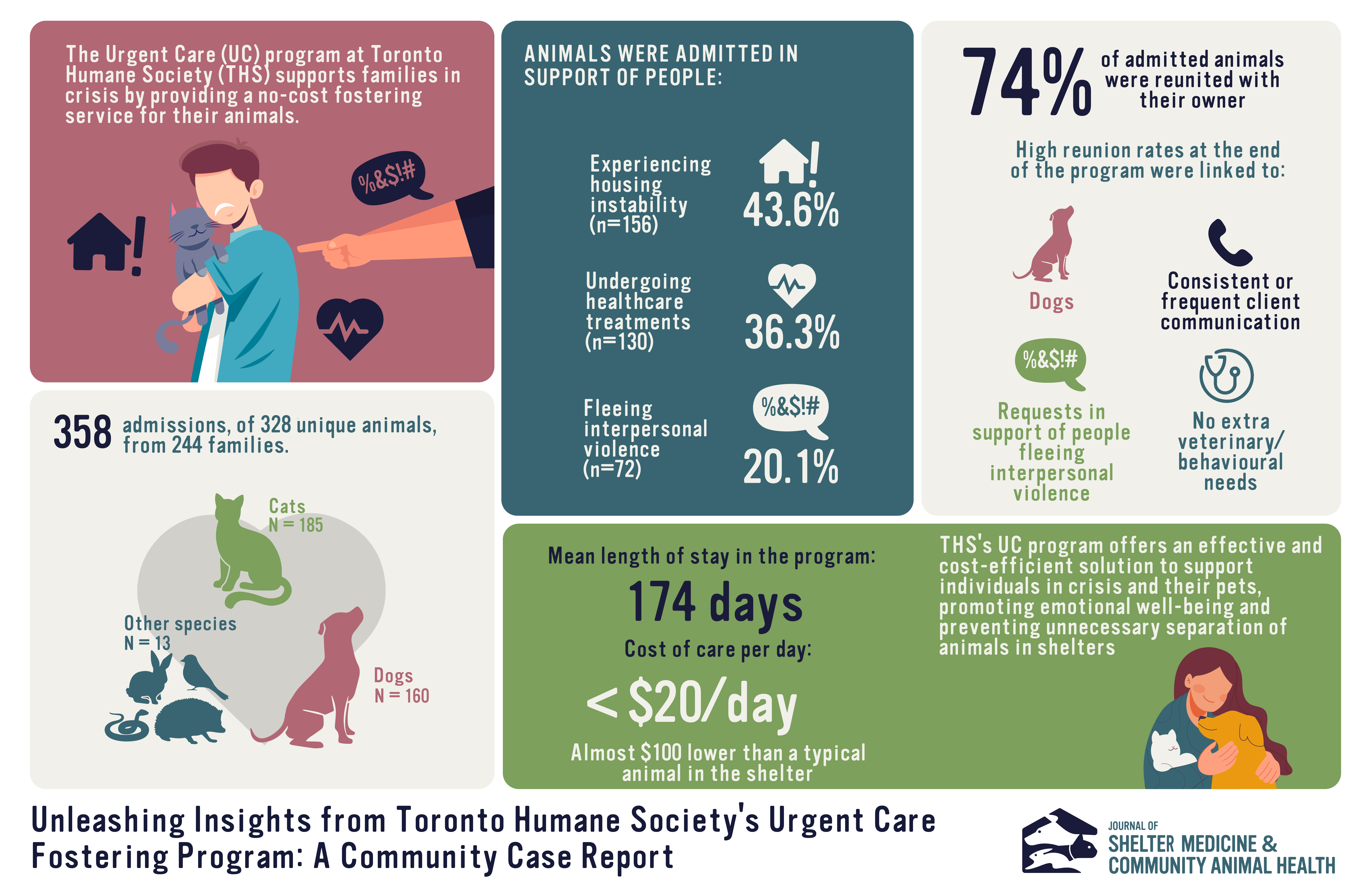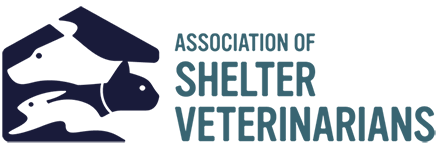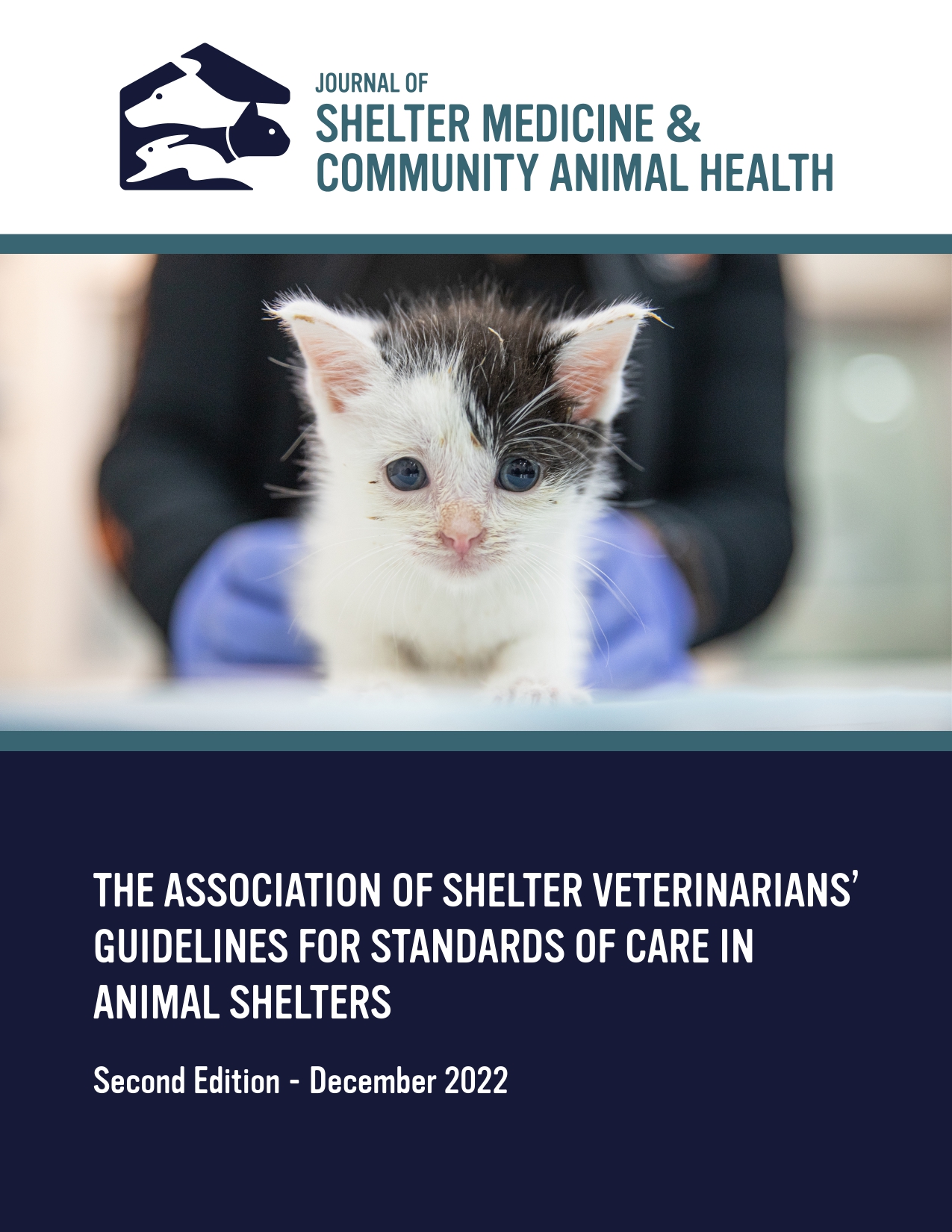Unleashing Insights from Toronto Humane Society’s Urgent Care Fostering Program: A Community Case Report
DOI:
https://doi.org/10.56771/jsmcah.v3.82Keywords:
Human-animal bond, housing instability, homelessness, interpersonal violence, domestic violence, healthcare treatments, hospitalization, multispecies families, pet safekeeping, boardingAbstract
The Urgent Care (UC) fostering program at the Toronto Humane Society (THS) supports individuals experiencing crisis situations (housing instability, fleeing interpersonal violence, or undergoing healthcare treatments), by providing a no-cost fostering service for their animal(s). All applications to THS’s UC program between January 1, 2020 and October 1, 2022 and all successful admissions to the program during this period were included in this study. There were 358 admissions of 328 unique animals, from 244 families. Seventy-four percent (n = 265) of admitted animals were reunited with their owner. The highest rates of reunion at the end of the program were linked to dogs, requests in support of people fleeing interpersonal violence, consistent or frequent communication with the client, and not requiring veterinary or behavioral care/training beyond standard levels. THS’s UC program presents an inexpensive and effective way to help support people undergoing temporary crises, preserving the human–animal bond, which may help them heal in the aftermath of these crises, and prevent the needless relinquishment of animals to shelters. Through writing this report, opportunities have been identified for improving the program to better serve our community, and details have been provided that might help other organizations operating or planning to launch a similar program.
Downloads
References
Hoy-Gerlach J, Townsend L. Reimagining Healthcare: Human–Animal Bond Support as a Primary, Secondary, and Tertiary Public Health Intervention. Int J Environ Res Public Health. 2023;20(7):5272. doi: 10.3390/ijerph20075272
Compitus K. The Biopsychosocial Model as a Framework for Understanding the Human–Animal Bond. In: Compitus K, ed. The Human-Animal Bond in Clinical Social Work Practice. Essential Clinical Social Work Series. Springer International Publishing; 2021:15–25. doi: 10.1007/978-3-030-87783-5_3
Gee NR, Rodriguez KE, Fine AH, Trammell JP. Dogs Supporting Human Health and Well-Being: A Biopsychosocial Approach. Front Vet Sci. 2021;8:630465. doi: 10.3389/fvets.2021.630465
Applebaum JW, MacLean EL, McDonald SE. Love, Fear, and the Human-Animal Bond: On Adversity and Multispecies Relationships. Compr Psychoneuroendocrinol. 2021;7:100071. doi: 10.1016/j.cpnec.2021.100071
Canadian Animal Health Institute. 2022 – Latest Canadian Pet Population Figures Released | Communiqués de presse. Canadian Animal Health Institute. Published May 3, 2023. https://www.cahi-icsa.ca/fr/press-releases/2022-latest-canadian-pet-population-figures-released. Accessed August 22, 2023.
French SK, Pearl DL, Lem M, Kilborn S, Donnelly B, Slater M. Understanding the associations between owner and pet demographics on pet body condition among those experiencing homelessness and housing vulnerability in Canada. Prev Vet Med. 2021;195:105454. doi: 10.1016/j.prevetmed.2021.105454
Government of Canada SC. The Daily – Canada’s Population Estimates: Total Population, July 1, 2018. Published September 27, 2018. https://www150.statcan.gc.ca/n1/daily-quotidien/180927/dq180927c-eng.htm. Accessed January 16, 2024.
Statistics Canada SC. Victims of Police-Reported Family and Intimate Partner Violence in Canada, 2021. Published October 19, 2022. https://www150.statcan.gc.ca/n1/daily-quotidien/221019/dq221019c-eng.htm. Accessed August 22, 2023.
Fitzgerald AJ, Barrett BJ, Stevenson R, Cheung CH. Animal Maltreatment in the Context of Intimate Partner Violence: A Manifestation of Power and Control? Violence Against Women. 2019;25(15):1806–1828. doi: 10.1177/1077801218824993
Bellows J, Berg ML, Dennis S, et al. 2019 AAHA Dental Care Guidelines for Dogs and Cats*. J Am Anim Hosp Assoc. 2019;55(2):49–69. doi: 10.5326/JAAHA-MS-6933
Valiyamattam GJ, Kritchevsky J, Beck AM. Demographics and Outcome of Dogs and Cats Enrolled in the PetSafe program at the Purdue University College of Veterinary Medicine: 2004–2019. JAVMA. 2022;260(2):228–233. doi: 10.2460/javma.20.09.0522
Hawes S, Kerrigan J, Hupe T, Nawyn T, Morris KN. Estimating the Cost to Care for Animals at Austin Pets Alive. Maddie’s Fund. 2020. https://www.maddiesfund.org/assets/grants/FinalReports/cost-for-care-at-apa.pdf. Accessed April 4, 2024.
Horecka K, Neal S. Critical Problems for Research in Animal Sheltering, a Conceptual Analysis. Front Vet Sci. 2022;9. doi: 10.3389/fvets.2022.804154
Karsten CL, Wagner DC, Kass PH, Hurley KF. An Observational Study of the Relationship between Capacity for Care as an Animal Shelter Management Model and Cat Health, Adoption and Death in Three Animal Shelters. Vet J. 2017;227:15–22. doi: 10.1016/j.tvjl.2017.08.003
Causa O, Soldani E, Luu N, Soriolo C. A Cost-of-Living Squeeze? Distributional Implications of Rising Inflation. OECD; 2022. doi: 10.1787/4b7539a3-en
Coe JB, Young I, Lambert K, Dysart L, Nogueira Borden L, Rajić A. A Scoping Review of Published Research on the Relinquishment of Companion Animals. J Appl Anim Welf Sci. 2014;17(3):253–273. doi: 10.1080/10888705.2014.899910
Ly LH, Gordon E, Protopopova A. Exploring the Relationship Between Human Social Deprivation and Animal Surrender to Shelters in British Columbia, Canada. Front Vet Sci. 2021;8. doi: 10.3389/fvets.2021.656597
Protopopova A, Gunter LM. Adoption and Relinquishment Interventions at the Animal Shelter: A Review. Anim Welfare. 2017;26(1):35–48. doi: 10.7120/09627286.26.1.035
Ly LH, Gordon E, Protopopova A. Inequitable Flow of Animals in and Out of Shelters: Comparison of Community-Level Vulnerability for Owner-Surrendered and Subsequently Adopted Animals. Front Vet Sci. 2021;8. doi: 10.3389/fvets.2021.784389

Published
Issue
Section
License
Copyright (c) 2024 Jacklyn J. Ellis, Dillon Dodson, Larisa Nagelberg, Rachel H. Bedder

This work is licensed under a Creative Commons Attribution 4.0 International License.









